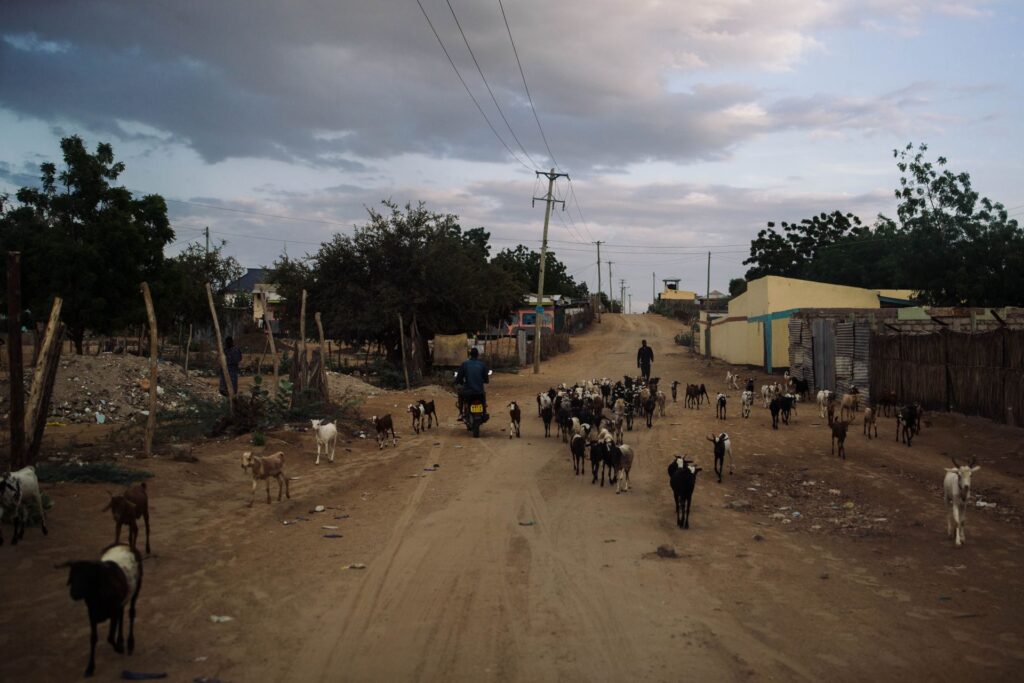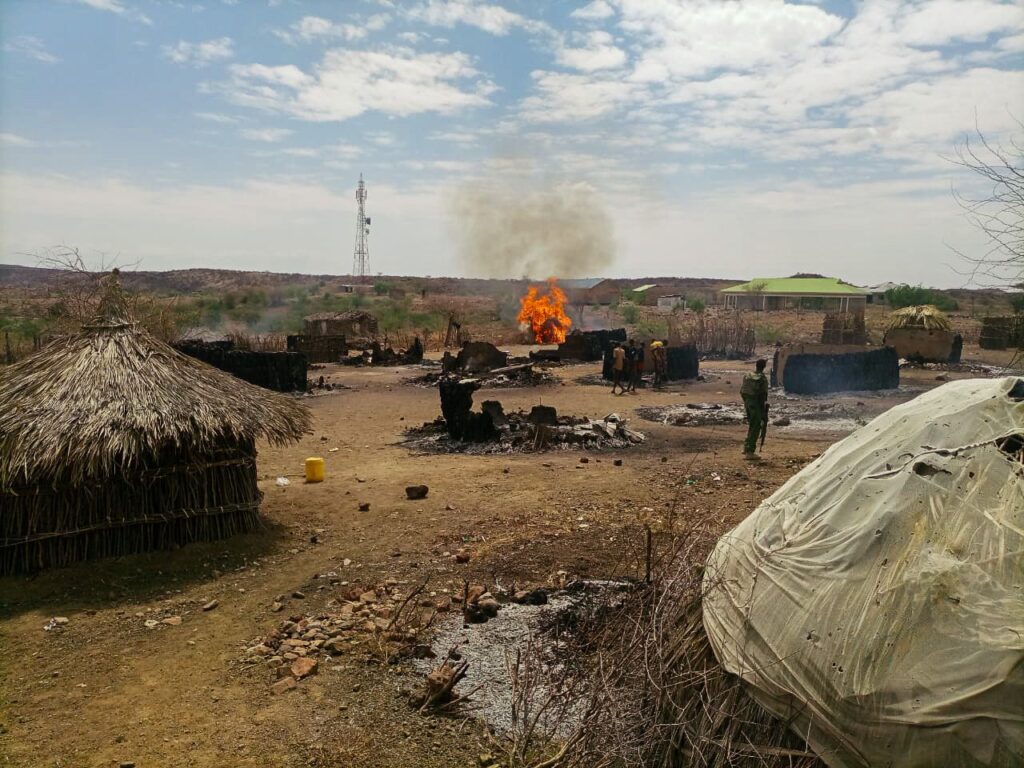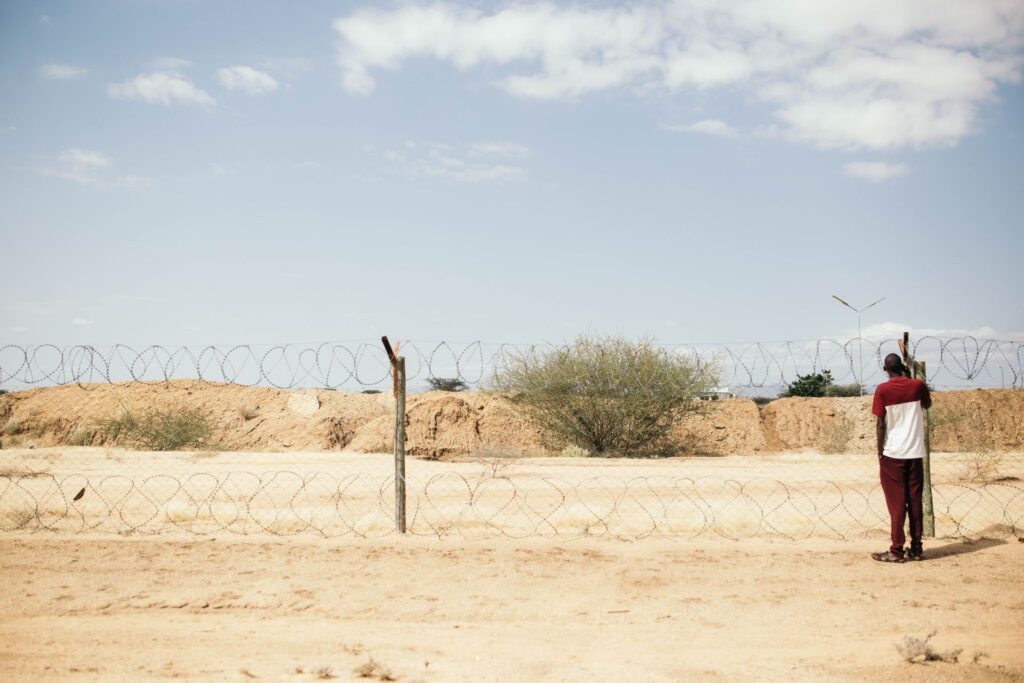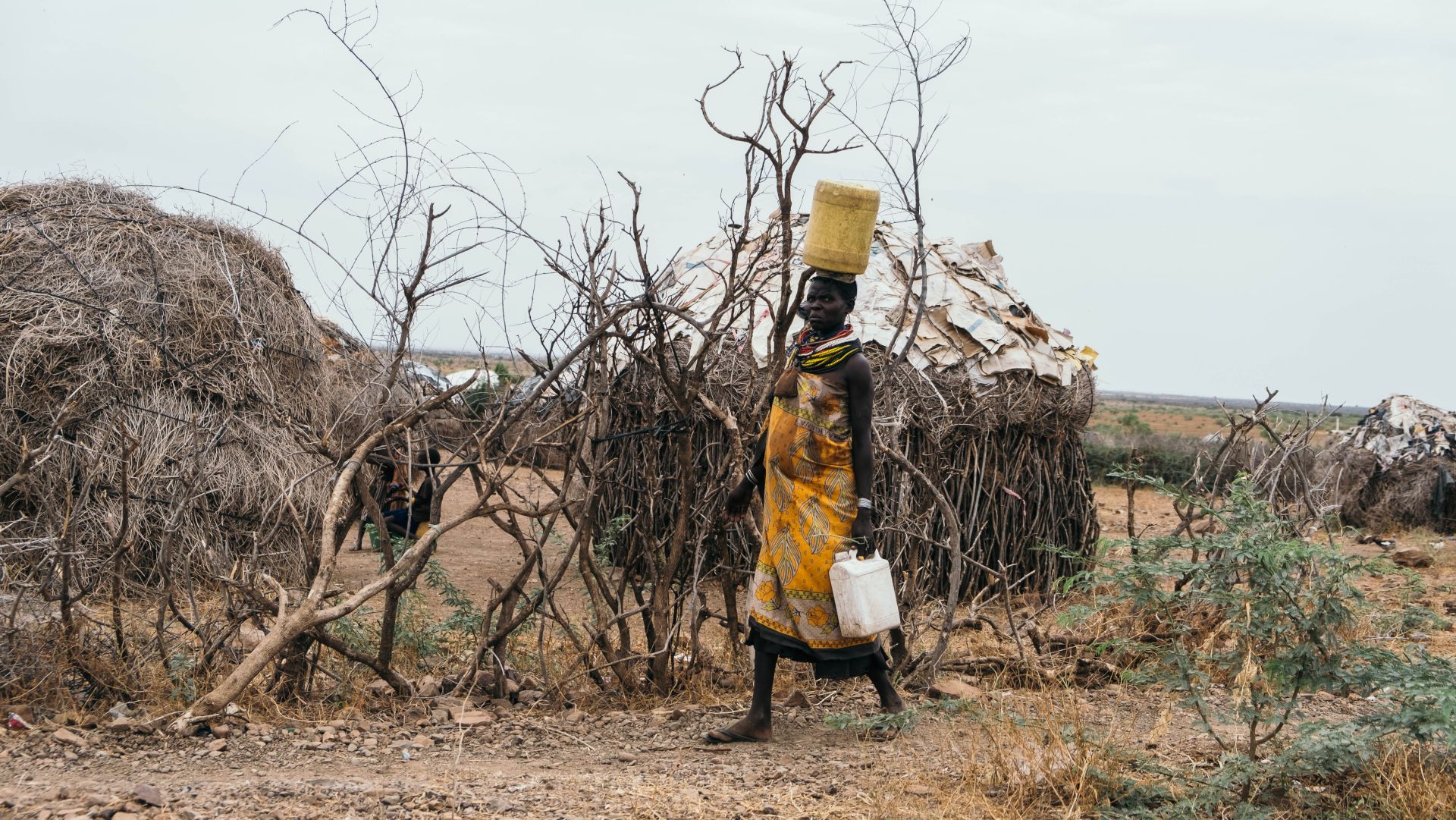There was an attack the day Joshua, who is using a pseudonym to protect his identity, was born on Oct. 10, 1999, in Kapedo — a small village straddling the border of Turkana and Baringo counties in northern Kenya. “I was born into stress,” he says over tea on a sweltering evening in Lodwar, Turkana’s capital. “There were many people killed that day, including police reservists. I don’t remember a time when I didn’t fear what would happen next.”
Throughout his life, Joshua has seen neighbors and relatives killed, including both of his brothers on the same day. At age 13, he was sitting in the back of a militarized police truck — a common way to travel given the security situation — on his way to Lomelo, an even more remote village, 25 miles northwest of Kapedo. There were about 30 people, all civilians, crammed together with shopping parcels and chickens. Without warning, a swarm of nearly 50 armed Pokot militia ambushed them.
“They forced the truck to stop and pulled everyone out,” Joshua recalls. “They killed the chief of Lomelo and some others. Everyone else ran to the bush to hide.”
The truck was burned to the ground. It took hours for reinforcement police to rescue the injured. Joshua had hurt his leg jumping down from the vehicle and says that there are people who never fully recovered from their injuries.
Having grown up in a land of pastoralists, Joshua says that armed cattle raiding is commonplace. This is particularly true in transboundary regions, where territorial lines between two communities are frequently blurred. Still, that didn’t explain the surprise assault or its sheer violence.
“It wasn’t clear what they wanted,” Joshua says. “We didn’t have any goats or cows with us. The aim was just to kill.”
People in Turkana, Kenya’s largest county, have been waiting for substantial rains after three years of drought. Dubbed the “cradle of mankind” for its prolific fossil sites vital to understanding human evolution, Turkana is home to several nomadic herding tribes. They move with their cattle, camels and goats in constant search of grass and water, often along the desiccated scars of intermittent rivers. This has always been a difficult place to live, nearly 24,000 square miles of arid landscape, about the size of West Virginia, despite being home to the world’s largest desert lake. This recent spate of droughts feels worse than what younger generations have ever known. Some have even decided to leave pastoralism for other livelihoods, such as fishing.
The British, who colonized Kenya from 1895 to 1963, left Turkana largely untouched, preferring more arable areas of the country. According to records from the colonial administration, it is of “no value to anyone except the Turkana,” which described the county as “the most worthless district in Kenya.”
Although officially recognized as one of Kenya’s more than 40 ethnic groups, the Turkana bear a complicated provenance, says Samuel Derbyshire, an anthropologist at the International Livestock Research Institute in Nairobi. “Its coherent ethnic identity didn’t really form until the 1850s or so,” he explains, when there was a “massive territorial expansion led by a military leader called Lokerio.”
Lokerio’s legacy instilled pride and motivated the Turkana to appreciate and protect their unique identity. One of the young men he inspired was Loolel Kookoi, a respected diviner and medicine man who united his people in the 1910s to resist British invasion. The Turkana easily outmaneuvered foreigners in the desert that they call home. Kookoi was eventually captured by the British as part of a massive retaliatory military campaign and disappeared. Even after the nation gained independence in 1963, the colonial attitude of disparaging the Turkana continued under Kenya’s first leaders. It remains one of the most marginalized regions in Kenya, where an estimated 8 in 10 people live in extreme poverty.
When nearly 3 billion barrels of crude oil were discovered beneath Turkana’s South Lokichar Basin in 2012, there was finally an incentive to invest in the region. Politicians walked back the parochial tone they had previously used to describe Turkana, and former Kenyan president Mwai Kibaki called the exploratory drilling a “breakthrough.” There was newfound national interest in Turkana in anticipation of rises in foreign exchange and wealth from drilling the oilfields.

The whole of northern Kenya is often overlooked and misunderstood, Derbyshire says. “Ecologically speaking, things are in a constant state of disequilibrium. There’s never been a point where things are stable.” Yet the remarkable thing, the researcher continues, is how communities across drylands have been specifically tuned to deal with these stresses since time immemorial. “What’s going to be changing is the reliability of these [environmental] factors. It has become hard to tell between wet and dry seasons.”
Turkana borders Ethiopia, South Sudan and Uganda. The human-made demarcations can be ambiguous, mattering little to those living there. For centuries, Ethiopian Nyangatom and Daasanach herders would periodically cross into Turkana and vice versa. Although this intermingling could be friendly, heated clashes were to be expected, particularly when poor rains resulted in grazing scarcity or disease outbreaks.
Pastoralists have long armed themselves with weapons like clubs and spears to protect their animals. But with the ease of access to small arms, mainly AK-47s and M16 rifles, security is reaching a boiling point. In 2017, there were an estimated 740,000 illegal firearms in Kenya, originating in part from conflicts raging across porous borders in South Sudan, Somalia and portions of Ethiopia.
“Everyone has a gun here,” says Gabriel Naspaan, executive director of the Turkana Development Organization Forum. “It can even be easier to buy guns than food sometimes.”
One explanation for the heightened violence plaguing Kenya’s pastoralists is the commercialization of the cattle trade. Beef is one of the country’s most popular meats; the urban butchery business is worth at least $500 million. Cattle raiding was once part of coming-of-age practices: Boys would steal animals to prove their cleverness and strength. On a small scale, these thefts would balance community power and wealth. But over recent decades, raiding has burgeoned into a seemingly unstoppable network of organized crime.
Naspaan says the Kenyan government has a history of quietly allowing disputing pastoralists to resolve their own conflicts. “The government knows that their jurisdiction is limited in such places, where the terrain is treacherous and difficult to access.”
Now some Turkana, after years of provocation and failed attempts at peace, are ready to fight back. “We are warriors, we have guns — we can’t wait for security [from] Nairobi, while our wealth is being taken away,” Naspaan tells New Lines. “We cannot allow it.”
Frankline Edong’a is a 24-year-old student from Lomelo who, thanks to his top grades, received a scholarship in 2020 to study in the U.S. He and Joshua attended school together in Lodwar and grew up in the same high-stress environment where death and violence were normalized.
Although cattle raiding has evolved since the early 20th century, Edong’a feels that the attacks have taken on a life of their own. Perhaps, he says, the drivers have shifted from acquiring natural resources to inflicting terror.
“What makes it difficult is that no one really knows what’s going on,” he says over an encrypted call in February, after he had learned of his brother-in-law’s murder. “Even if you have no animals with you, [if] you’re just gathering water, you’re still targeted. You don’t have the freedom to go outside.”

“For most people, Lomelo might seem like it doesn’t have anything to offer,” Edong’a continues, his voice quiet. “People may wonder how exactly Turkana contributes and fits into the Kenyan economy. But that blinds you. We forget about the humanity — how do people live, how do people survive. These are citizens of the same country that need attention from the government.”
Markers of success and wealth have changed, and this could also play a role in the violence. “Conflicts used to be a community affair,” Edong’a explains. “Youths would gather before elders, who communicated the importance or need for raiding. There’s a disconnect now, between elders, chiefs and boys — there’s the element of personal gain.”
James Farr is a former outdoors educator at Mukutan Conservancy in central Kenya, who worked to build peace among stakeholders living in volatile regions. He senses a generational severance within the Pokot community, between wise and experienced elders and agitated young men. From his time in the field, he sees how the Tugen, Turkana and Marakwet — all of whom suffer from Pokot banditry — also discern the difference. Organized raiding with a territorial aim is distinct from ordinary intercommunity strife, Farr says.
“The [Pokot] elders say ‘kunyanyasa,’ meaning they violently oppress such behavior, and I believe them,” he continues. The young men — the ones launching the attacks that make places like Lomelo a living hell — seem to be going rogue. Farr, like many others, suspects malevolent actors from the community and in the political world, who are playing the “long game” for power and financial gain.
These schisms are exacerbated by the myriad political and developmental changes swirling across Kenya. There’s the very traditional Pokot, distanced from the rest of Kenyan society, who operate within traditional frameworks. Some may feel that aggression is the only way to get what the world owes them. And then there’s the self-identified elite — an educated group that knows how to engage in political systems and quietly carry out commercial criminal activity.
“The police aren’t effective, since all this is happening out of their depth,” Farr explains. There’s no incentive for them to risk their lives on issues that have been plaguing northern Kenya for decades. “I’ve heard that Kenya Wildlife Service (KWS) is the only security agency that Pokot militia are afraid of, since they often employ locals familiar with the terrain who are willing to go into the bush to fight,” he says. But it’s well known that KWS, authorized to protect wildlife rather than quell conflict, is underfunded and faces constraints even within mandated national parks.
The relentless, unnerving attacks on Kapedo and Lomelo — often cast as mere incidences of “banditry” by local media and politicians — have been so vicious that even the Kenyan government, usually laissez faire when it comes to security in the north, has been forced to step in. By 2014, attempts to bolster Lomelo’s security had morphed the village into a garrison town. The Rapid Administration Unit, an offshoot of the administrative police — established a militarized police base outside Lomelo.
“The police refrain from going into the village, claiming it’s too dangerous,” says Connor Cobb, who works in global human development and is a friend of Edong’a. During his 10-day visit in Lomelo in 2022, Cobb noticed high levels of alcohol consumption in the village — one of the few coping mechanisms available to escape the pain and stressors of living in a place that never feels safe.
“At this point, it’s a bit too simplistic to attribute the raids on Lomelo to mere climate change,” Cobb tells New Lines. “That shifts the attention away from more insidious underlying motives.”
Yet Derbyshire, the pastoral researcher, doesn’t necessarily see this current wave of violence — exacerbated by guns, the growing meat market and meddling politicians — as discontinuous from the nature of conflicts woven into these societies. The banditry networks, in a way, are a response to discrimination that pastoralists face — urban elites have long written off pastoralists for their lack of formal education. “Every generation wants to prove something, react to who came before them and how they did things,” he says, “to make sense of the world.”

“Us youth, we suffer the most from all this,” Joshua says. He’s studying nutrition and dietetics at Kibabii University in Bungoma, western Kenya — more than a day’s worth of travel from his home village. “There are no good schools in Kapedo and high rates of depression. When these attacks happen, you don’t know where to go. The youth are supposed to have good things ahead of them. These attacks disrupt our entire way of living.”
A 44-year-old resident of Kapedo who requested to go by the pseudonym “Mary,” out of fear of recrimination from local authorities, claims that she will never move from her hometown. “Everything I know is here. My parents were born here, and I will die here,” Mary tells New Lines. These days, Kapedo is mostly inhabited by women and children. Most of the men are gone, either dead or in search of work in cities.
Mary has lost her father, stepmother and several other relatives over the years. She has meticulously recorded the names of the deceased, noting the circumstances under which they were murdered. Through her notes, one can see the gradual progression from animal raiding in the 1990s to now, where people are slain for no apparent reason. There was the mother who went to fetch water from the river, the secondary student walking to school and the two boys fishing together.
“We’ve tried [to achieve] peace so many times, so many times,” she says. “We have peace meetings between Pokot and Turkana chiefs, with members from the county assembly, and even [members of Parliament]. Every time, [the Pokot] claim they will contain peace, but days later, someone else will be killed.”
There’s no clear roadmap for those in power. Some Lomelo residents believe that the government is trying its best, sending in troops across targeted regions to flush out the bandits. “The police lose their own troops who are overpowered by these Pokot,” Joshua says.
Mary sees the situation differently. “If the government of Kenya was serious to stop this thing, it would end,” she says scathingly. “With al-Shabaab [a Sunni militia in East Africa], the government came in with all forces. But there are people in government who are benefiting from our tragedies, people who are involved.”
Even in the cold season, Turkana’s heat is formidable. But as the sun goes down, the dry brush is uniquely beautiful. Apricot-colored light shatters through clouds of dust thrown up by scratching chickens and playing children. This has never been an easy place to live, and in the face of such repeated cold-blooded raids, it’s hard to understand how anyone can stay.
In January 2021, portions of Kapedo had been burned to the ground, and many people perished. “I wrote this in my diary, when I was really bitter,” Mary shares: “The women of Kenya should come to cry with us. What’s happening here is affecting Kenya, not just us.”
To this day, Edong’a remains conflicted about whether the fighting is about resources or territory. He sees why Joshua blames Lomelo’s and Kapedo’s deterioration and banditry wholly on the Pokot.
“But back-and-forth blame is part of the problem,” Edong’a adds. “I have lost people I really care about. If you don’t have a discussion with an open mind, each person will only see the world from how it affects them. We’ve never moved past this, and most don’t want to have these conversations beyond this emotional trap.”
This story was produced with funding support from the Pulitzer Center for Crisis Reporting.
Become a member today to receive access to all our paywalled essays and the best of New Lines delivered to your inbox through our newsletters.



